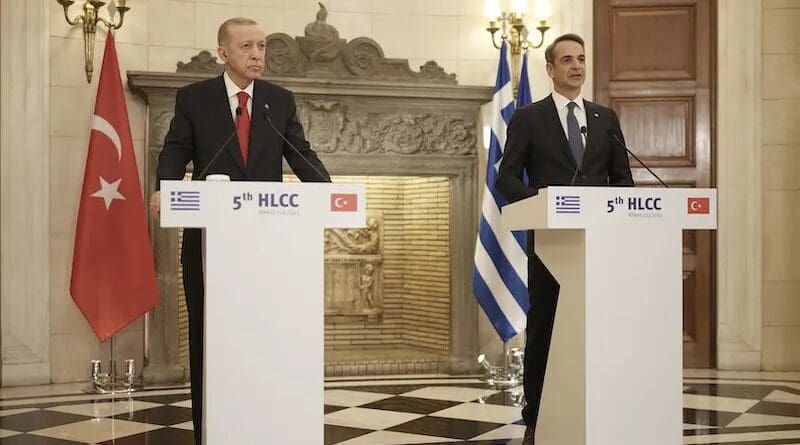Positive Talks In Regional Disputes Offer Light Amid The Gloom – Analysis
By Arab News
By Luke Coffey
With Russia’s war against Ukraine showing no signs of letting up, and Israel’s assault on Gaza intensifying each day, some of the world’s older disagreements and conflicts are receiving less attention. However, there have been positive developments that deserve recognition in two long-standing disputes. It is possible that the beginning of a new era of rapprochement between Turkiye and Greece in the Aegean Sea, and Azerbaijan and Armenia in the South Caucasus, is taking place.
A recent meeting in Greece between Turkish President Recep Tayyip Erdogan and Greek Prime Minister Kyriakos Mitsotakis led to a diplomatic breakthrough.
Turkiye and Greece have been at odds over numerous issues going back more than a century. In modern times, the main source of tension is found in the Aegean Sea. Greece has accused Turkiye of weaponizing refugee flows into Europe through the area. Ankara has accused Athens of militarizing islands just off the coast of Turkiye. Meanwhile, there is disagreement between the two countries over which controls various islands in the sea.
This situation almost led to war on at least two occasions. For Ankara, this is a particularly important issue. The status of the islands has a direct impact on how Turkiye’s territorial waters are determined. As more natural resources are discovered in the eastern Mediterranean, the issue of determining which country controls which area has become more important than ever.
Relations between Ankara and Athens have been at a low in recent years. Last year, evidence emerged on social media suggesting that Greece was militarizing disputed islands as close as 5 km from the Turkish coastline. Turkiye argues that former agreements, such as the 1923 Lausanne Treaty, banned the presence of military forces on certain islands in the Aegean.
During Erdogan’s visit, both sides agreed to reestablish communication mechanisms between each country’s militaries in order to avert a misunderstanding that might lead to fighting. The two leaders also pledged to double the amount of trade in the coming years. But after years of harsh rhetoric by both sides, it was the congenial tone of the visit that stood out. At a press conference, Erdogan said: “There is no issue between us that is unsolvable … We want to turn the Aegean into a sea of peace.”
Both sides stand to benefit from rapprochement. Greece could use an economic boost from increased trade with Turkiye. Erdogan, always the pragmatist, understands that settling issues with Greece in a satisfactory manner allows his focus to be placed on more pressing geopolitical challenges in the Black Sea and Middle East.
Meanwhile, much-needed good news has been coming out of the South Caucasus.
At the same time Erdogan was in Greece, senior officials from Armenia and Azerbaijan released an unprecedented joint statement offering the strongest commitment to date for normalizing relations.
The origins of the Armenia-Azerbaijan crisis are fairly recent. The conflict began in 1988 when both were still part of the Soviet Union. At this time, a local assembly in the ethnic Armenian region of the Azerbaijan Soviet Socialist Republic voted to join the Armenian SSR. In 1991, a sham referendum was held in the same region on whether the ethnic Armenian enclave should become independent. The Azerbaijani minority boycotted the vote. Both the local assembly’s vote in 1988 and the referendum in 1991 were considered illegitimate under existing laws. Yet, these votes eventually led to a bloody war between Armenia and Armenian-backed separatists and Azerbaijan that left 30,000 people dead, and many hundreds of thousands more internally displaced.
By 1994 the conflict was frozen, with Armenian forces controlling a sizable amount of territory recognized by the international community to be a part of Azerbaijan. Periodic skirmishes took place between the two sides until a major war in 2020, followed by a smaller one-day skirmish last September, led to Azerbaijan taking back all the territory it had lost in the 1990s. This led to a mass exodus of ethnic Armenians back to Armenia and the beginning of the return of ethnic Azerbaijanis who were expelled in the early 1990s.
After the meeting last week, both sides issued a joint statement saying that “there is a historical chance to achieve a long-awaited peace in the region,” and that the “two countries reconfirm their intention to normalize relations.” Speaking in Yerevan this week, the Armenian Prime Minister Nikol Pashinian reiterated his support for reopening existing transport links with Azerbaijan. In addition, a major prisoner swap took place this week between the two countries.
Recent talks regarding Armenian-Azerbaijani normalization are noteworthy because of the absence of other major powers. In recent years, any progress made in peace talks between the two sides has been facilitated by Moscow, Brussels or Washington. This time, none of those big players has had a direct role. Normalization benefits both sides. Armenia desperately needs to improve its transit connectivity with the outside world. Also, normalizing with Azerbaijan will likely lead to Armenia reestablishing diplomatic relations with Turkiye. Both countries would benefit from an influx in foreign direct investment if genuine peace and stability was restored in the region.
The news coming from the Aegean Sea and the South Caucasus is welcome at a time when most of the world’s headlines are filled with gloom. Just weeks ago, many would have thought a breakthrough in either region would have been unlikely, if not impossible.
The engagement between Greece and Turkiye, and Armenia and Azerbaijan, should inspire global policymakers not to give up hope of resolving some of the world’s most seemingly intractable issues. Time will tell if either region will achieve a lasting peace, but recent actions are a good place to start.
- Luke Coffey is a senior fellow at the Hudson Institute. X: @LukeDCoffey

